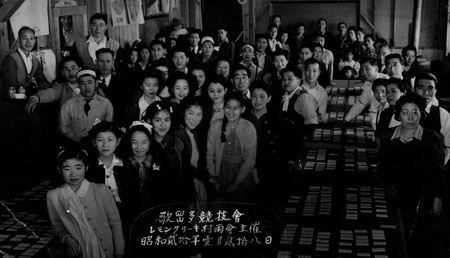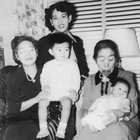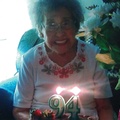The life in Lemon Creek settled down to mundane everyday life. There was no running water in the individual homes. The pipes ran outside the houses, the faucets in the sink from the network of pipes were meant to serve every five or so homes. The people would not stand for this system. With winter coming, people just helped themselves to enough material to pipe in water into their own homes. Dad did the same to ours. This made life easier for the people not having to lug pails of water into their homes.
The people were energetic and resourceful – they dug, planted, watered, had larger and larger vegetable gardens so that one would have a huge source of produce in their own backyards. Mom and Dad did the same. They also had some chickens fenced in the back for our own use. The only drawback was the outhouse; we city folks would never get used to it. Here also, Mom was indispensable – she herself kept it clean. I don’t know how she did it.
Mary was not a healthy child. I think she suffered from pleurisy and often was confined at the hospital in Slocan City. A Mr. Okamoto, who was once a boarder on Powell Street made a habit to visit Mary at the hospital on a regular basis. He was roomed at one of the bunkhouses in Popoff with other men with no family. After the war, he returned to Japan; we never heard from him. Around this time, 1944, penicillin (a miracle drug) was discovered. The medical staff at the Slocan City hospital thought this new drug may help my affliction, but it was not to be.
After Mary was well enough to be discharged from the hospital, she attended Japanese Language Class in Lemon Creek (not officially recognized). Betty and Shirley were already enrolled in the classes. The basement of the next-door neighbor was converted to a classroom by Mr. Yamashita, a carpenter by trade. The classes were taught by a Mr. Kanamitsu; his elder daughter, Toshiko, was one of my classmates at Vancouver Japanese Language School. The family went to Japan after the war; Toshiko married an American serviceman and came back to live in Texas. Her father and sister accompanied them to Texas and they visited Toronto years later for reunions.
There was an incident when one of the sons of a family appeared to have gotten lost in the wilderness up in the mountains. All the men organized and made search parties to tramp in various areas searching but without success. It was said later that he had been seen in Eastern Canada. Maybe he just wanted to get away from under his parents’ thumb.
Life moved along quite peacefully, more or less. There were two stores which provided the necessities of everyday living, movies were shown, school dances held, concerts were performed, and there was a harmonica band led by Bob Kumano (Frank performed with them before he left Lemon Creek). Even baseball tournaments were held between members from other settlements. Betty and Shirley enjoyed performing odoris once in a while.

There was one undertaking which I enjoyed, a game of karuta. People of all ages could take part, and since it was a little difficult game to play, not everyone was interested, involving a lot of study and memorizing. Both Betty and Shirley were pretty good at this game. We would challenge players from other settlements. I remember going to New Denver and staying with the Tanabes (formerly a jeweller in Vancouver) and participating in a tournament the following day.
Betty and Shirley attended public school. I think Betty was a member of the student council. She did well in school, appeared in the Spelling Bee but was knocked out in the first round; she got stuck by a simple word, leaving her in tears. She was also a candidate for May Queen which she also lost.
After a couple of years living in the community, an apple ranch, “The Coldstream”, decided to hire young people living along the Slocan Valley to work thinning and picking apples, and other related work. A truck was sent to several centres to pick up these hired hands, one of the drivers happened to be the son of the Idenouyes of Vancouver. Pat, one of my current friends, was one of the workers but I did not have an opportunity to further our friendship. She was a resident of Bay Farm, another relocation centre located in the same area as Lemon Creek. Mrs. Matoba, wife of one of the famous Asahi players, was the cook at the camp and she gave us some hints in baking.
I must have worked about a week, struggling with a pretty high ladder thinning apples; also helping out at a neighbourhood farm (the Kawanos) with their strawberries in the evening. I never tasted strawberries so sweet and tasty. The daughter, Nellie, later became engaged to Toru Idenouye.
I had a dinner invitation from the Nishimuras of Vancouver who had relocated to the Okanagan area when war broke out and having heard that I (a relative of sorts) was at Coldstream Ranch invited me to dinner. It was a treat to go to dinner away from the ranch. Unknowingly, I met my future brother-in-law, Bob’s sister Day, who happened to be married to Nishimura’s eldest son, Shig.
The adventure of working with a bunch of girls did not last long. The unfortunate incident of my skin problem reared its ugly head. The food inspector noticed it and asked that I kindly resign because apples are for human consumption and my problem may not pass health authorities. Since the ranch could not send a truck back for one individual, I had to ride on the back of a provision truck, “Burns”. We did not make it back in a day; we stopped for the night in Nakusp, where there was a depot/store for the trucks. A Japanese girl, Mickey Nishimura (her family, I believe, lived in Lemon Creek) was working at this depot, gave me supper and directed me to the only hotel in town for the night.
Unfortunately, the hotel was closed for the night, although I would not have known how to register anyway. Since the weather was warm, I decided to spend the night on the veranda where there were comfortable chairs. Then, an elderly Japanese couple came out of the hotel, saw me and told me to use the room they had just vacated. They were going to walk down to the dock and wait for the ferry to take them across the lake to Revelstoke in the morning. They never gave me their names, I don’t even remember what they looked like - I never saw them again. It was just an act of kindness to a lonely traveller. I doubt such a thing could happen nowadays. It was an incident that stayed in my memory because of their kindness.
The next morning I went back to the depot where Mickey gave me breakfast and I resumed my trip, finally reaching Lemon Creek. I don’t remember how long it took the second day to complete the trip.
Sewing Class with Mrs Minakata
Mom’s decision to send me to a sewing class which was conducted by a Mrs. Minakata was one of the best ideas she came up with. I learned basic pattern-making, sewing, etc. I had one paying customer, an elderly lady who allowed me to sew her a simple house dress. The Minakata’s went to Japan after the war and returned to Canada years later. (I think they were one of Ron’s earlier clients when he went into the real estate business in Toronto.) Their son, who was a young lad, became one of the stalwart members of the Wakayama kenjinkai when they returned.
We stayed in Lemon Creek for about a year after the war ended – so much confusion, so many decisions to make, the uncertainty of the future. When the war ended, we had to make a difficult decision – sign up and go to Japan, or travel east to Eastern Canada.
Uncle Kanichi and his family moved to Ontario with the rest of her family, the Nakano’s. Uncle Gengo and his family remained in a logging camp in B.C. where Aunt Yuki-chan died in childbirth leaving five young children, the newborn eventually adopted by an Alberta family. Years later, the youngest was reunited with her siblings in Vancouver where Uncle Gengo finally settled.
Dad made the decision to take a chance with Eastern Canada. He knew how chaotic Japan would be after the defeat of the war—food shortage, return of many repatriates (not being welcomed), not knowing how his family made out, unable to know how living conditions would be. He thought it was the lesser of the two evils to stay in Canada. We remained in Lemon Creek until August of 1946, packing up again for our final trip.
Mom prepared lunch to be taken on this trip. Finally, with her barbering career ending, she was able to dispose of her barber chair, together with the kitchen range, purchased by a resident in the area. The chicken in the lunch must have been the ones she had in the chicken coop.
Later, we learned that the Ishikawas decided not to take one of the two options offered by the Canadian Government; they moved on their own from Rosebery where they lived until the end of the war to Penticton, a fruit-growing community, hoping that eventually they may return to the B.C. coast where they were familiar with the fishing industry.
Eastward Bound—Settling in Toronto
I have no idea how many days we spent travelling on the train. I recall stopping in Winnipeg where many of the travellers disembarked, their final destination. I remember standing out on the street corner wondering what kind of a city Winnipeg was. I knew that Eaton’s had its headquarters here doing big business in catalogue sales.
We reboarded the train (the same day or next) and finally arrived in Toronto - for most of us it was the last day of travelling, with others continuing on. There were many Japanese at the terminal awaiting the travellers. Frank was there, so were the Kitagawas. Here was the start of another segment of our life.
We took a cab to the house which Frank was able to rent, owned by the people next door who ran a confectionery store. The house was really a sight to see, old and rundown, a little disappointing (I don’t know what I was expecting). We were able to have rooms on the second floor – one large bedroom, a smaller room for Frank, a sunroom to be used as another sleeping quarter and a fairly large living/dining room. There was a sink and a kitchen stove in the hallway. The washroom contained a bathtub, sink, and an old- fashioned toilet with a pulley to flush (thank goodness not an outhouse!).
As you can imagine, there was not much sleeping space. It did not matter to me - Mrs. Yae already had promised me as a live-in nursemaid to a family in north Toronto. It was a family of five; the man of the house was an executive of a rug company downtown, the lady was quite a well-known artist, the eldest son, Adrian, about 12 years old who was born a “blue baby”, a daughter, Natalie, about eight years old, and the baby of the family, Yvonne, who was my charge. Mrs. Seguin, the lady of the house, did most of the cooking; Mom’s cousin, Yae, came once a week as a cleaning woman; that’s how she found me the position. This is where my non-Japanese name “Katherine” (Kay for short) was created. The family could not pronounce or remember “Katsuyo.”
The year I started, the family took a year-end holiday trip to Florida with the two older children, leaving Yvonne in my charge. So, as not wishing to spend a holiday without the family, I travelled by bus down to my family with Yvonne.
During my employment with the Seguins, I attended night school at North Toronto Collegiate on my Wednesday days-off to further my business studies. After class, I would bus down to the Bathurst Street home wishing to spend what time was left with my family but they were all ready to retire, so I had to cut my visit short and return by bus to my place of employment. I stayed with the family for about six months. After my course at the collegiate was completed, I handed in my notice, informing them that I wanted to try another source of employment. They understood my intent, but after I left, they contacted me at home to see whether I would consider returning, which I refused.
When I went around looking for a better job, I discovered how poorly my English education prepared me for the outside world. Living in a non-English, Japanese-speaking community for the duration of the war was a deterrent.
In the meantime, Mom had a job as a seamstress at the main factory of Tip Top Tailors on Lake Shore Blvd. Yae’s daughter worked there. Dad had a job in Chinatown at a factory handling cloth sacks (to this day I really do not know what he actually did at his job only that he used a sewing machine).
Betty wished to further her education, but circumstances did not permit it, so regretfully she worked at Rose Marx Brassiers to help out the family and made many friends. Shirley enrolled at Central Technical School and worked part time at Parisian Laundry, and Mary went to Alexander Public School. Kenny was a sickly child with problems with his leg and was confined to a convalescent institution run by I.O.D.E. situated on Sheldrake Avenue off Yonge Street. I remember travelling there on weekends on old Yonge street cars which were warmed by bellied stoves in the cars during the winter months.
Shirley had a job doing housework with the Seguin’s lawyer friend during Easter Holiday. She was so enthusiastic, she used to get up quite early in the morning to vacuum the rooms. She was asked not to do so, it was too noisy so early. The wage they paid was so measly, it was not worth continuing the job.
We stayed at this Bathurst Street location for several years. Eventually, we were able to rent the entire house so we sub-rented it out to many people. There were the Nakamuras (Dad knew their father way back in those fishing days), a single Dutch man, a fellow from Thunder Bay. The Iwatas with the four sons stayed for a while. That is when their friends came to visit, and we had fun with all the young ones.
The house was so old and dilapidated, we were a little embarrassed to be seen coming out of it when we left daily for work as there was a Toronto Transit Commission (TTC) streetcar stop right in front with people waiting. We used to wait inside the door until the people left on street cars before we ventured out of the house.
The years went along quite uneventfully at this location. My friend from Lemon Creek, Fumiko’s family, lived a few blocks away with whom I got reacquainted. We attended Sunday church together. Betty and Shirley joined an odori group sponsored by the Buddhist church. Even in Toronto, Betty used to get a leading role, such as Madame Butterfly. Dad had his friends over for games of Hana-Fuda (Japanese Card Game – gaji) which he loved. Mom’s cousin, Yae, also liked this game and visited Dad often with her husband to play.
© 2021 Kay Mende






